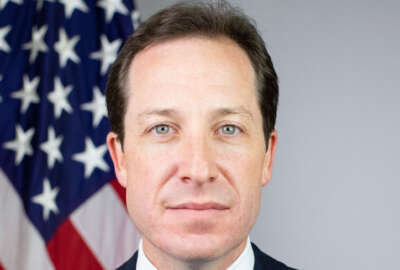Agencies advised to think ahead when working PMA goals into strategic plans
Agencies are expected to incorporate President's Management Agenda initiatives into their multi-year strategic planning, some of which, including the Commerce...
With only three top priorities of workforce, customer experience and improving business operations of the government, the Biden administration’s President’s Management Agenda is markedly different from years past.
Agencies are expected to incorporate PMA initiatives into their multi-year strategic planning. Some, including the Commerce Department, had an easier time doing this thanks to early insights from the Office of Management and Budget.
Harry Knight, director of performance and co-lead for strategic planning at Commerce and its acting executive director for China, said political leadership in the Office of the Secretary shared OMB drafts of the PMA along the way. But for agencies who did not, Knight said it was not too late to follow suit, one reason being that, “the process to get new executive orders signed and released also was very much in alignment with the new President’s Management Agendas. So within these pillars, there’s strategies. There’s also executive orders that backup and have required actions.”
During last week’s Government Performance Summit 22, Knight said Commerce leadership got an early jump on the pillar of promoting diversity, equity, inclusion and accessibility in the federal workforce, while the pillar on improving federal customer experience “is where we get a lot of bang for the buck.”
But, as focused as the PMA is, the competition for executive time and priorities persists. Knight advised entities to have synergy in accomplishing these priorities.
Similar to Commerce, NASA’s four-year strategic plan process benefited from working closely with the President’s Management Council, according to David Walters, chief of the strategic planning and performance management branch at the agency’s headquarters. NASA’s 2022 strategic plan has new objectives built around the Biden administration’s DEIA and climate goals. Walters said that, in building NASA’s 2022 strategic plan, the team determined prior strategic plans did not go far enough to demonstrate the agency’s existing efforts to combat climate change.
“So when we went about writing the new 2022 strategic plan, we made sure to include a strategic objective built around climate change research, and then another strategic objective around sharing that data with the rest of the world,” using language directly from the PMA, he said.
It has emerged as an important resource for the performance management community, and although Walters said NASA already considered itself a data-driven organization, the Foundations for Evidence-Based Policymaking Act of 2018 (Evidence Act) forced them to focus their energies.
“If you had come to me before the Evidence Act had been enacted, and you had said, ‘Talk to me about NASA’s major self-reflective activities. What kind of data do you use as you’re developing a strategic plan?’ and I probably would have given you 50 or 60 different answers. What the Evidence Act did is it kind of forced us to focus that down into a narrow list of priority questions, so that we now think of it in terms of ‘Yes, we’re looking at 50 or 60, but within that, here’s the five or six key priorities that we’re going to focus on for the next four years,’” he said.
As a messaging tool, the Evidence Act is helpful, and Walters said it forces all the CFO Act agencies to “talk in one voice” when having conversations around evaluation and evidence. The law also created a lift in workload from NASA’s 2018 strategic plan, which was 64 pages, compared to the over 100-page-long 2022 plan. Walters said it has changed how NASA does resourcing and disparate processes, as well as when they start strategic planning because of the additional requirements.
At the Commerce Department, Knight said the two statistical agencies — the Census Bureau and the Bureau of Economic Analysis — are ahead of the curve when it comes to implementing the Evidence Act requirements, but other less experienced Commerce sub-units may not be as far in integrating those requirements with their strategic plans. Knight acknowledged this is an ongoing challenge, especially since many of the new initiatives in evidence-based decision making do not come with additional funding, and it could take as much as two years to receive the budgetary support.
Therefore, it behooves agencies to consider budget needs and constraints in strategic plans even if the money is not currently available. In the meantime, getting processes and “learning loops” in place should not require additional funds, he said.
“And that’s what we’re looking at right now is we’re looking at FY 2024 budget formulation, is actually making the ask to all of our bureaus and programs,” Knight said. “Saying, ‘Hey, if you’ve got a learning agenda question, and oh by the way, similar to NASA we have three strategic objectives … Did you get any [funds] in your FY 2023 to support that analysis and learning? And then if not, are you getting it into your FY 2024 ask?’”
OMB updated the Circular A-11, which guides agencies on submitting FY 2023 budget requests as well as instructions on budget execution, to reflect Evidence Act requirements. This includes an “evidence submission” along with budget requests, and guidance on “implementing evaluation and evidence-building activities.”
Performance Institute CEO Jeffrey Yefsky said this would help agencies at the federal, city and county levels communicate both internally and to constituents.
“Government is a big business in the United States, and if you don’t have true guidelines or at least some type of a rule book to follow, you’re going to end up with a lot of mayhem and a lot of missed steps, and a lot of utilization of funds that don’t need to be utilized,” he said.
For his part, Walters said having the A-11 update helps every year and gives him the reinforcement to direct others in creating budget submissions. He also appreciated that OMB regularly asks him and his counterparts how A-11 updates could be more useful, which gives performance managers a voice in that update process. Yet he did not deny the lack of additional resources is hard to overcome.
“Just in terms of execution, resources present a huge challenge for someone like me, that has a team that’s used to working [in a] GPRAMA [GPRA Modernization Act of 2010] silo, and now being asked to build all these new Evidence Act products and processes into our work,” Walters said. “What I try to do is just stay positive. I try to remind everybody that the Evidence Act is still in its infancy … There will be resources that become available in future years, especially if we do the work well. And there’s a reason why this legislation was passed. We’re going to build on our prior efforts, and that ultimately it’s a good thing.”
Copyright © 2025 Federal News Network. All rights reserved. This website is not intended for users located within the European Economic Area.
Amelia Brust is a digital editor at Federal News Network.
Follow @abrustWFED






